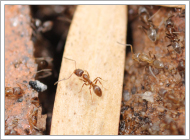Argentine Ant

The Argentine ant (Linepithema humile, formerly Iridomyrmex humilis) is a dark ant native to northern Argentina, Uruguay, Paraguay, and southern Brazil. It is an invasive species that has been established in many mediterranean climate areas, inadvertently introduced by humans to many places, including South Africa, New Zealand, Japan, Easter Island, Australia, Hawaii, Europe, and the United States.
They have been extraordinarily successful, in part, because different nests of the introduced Argentine ants seldom attack or compete with each other, unlike most other species of ant. In their introduced range, their genetic makeup is so uniform that individuals from one nest can mingle in a neighboring nest without being attacked. Thus, in most of their introduced range they form "supercolonies". "Some ants have an extraordinary social organization, called unicoloniality, whereby individuals mix freely among physically separated nests. This type of social organization is not only a key attribute responsible for the ecological domination of these ants, but also an evolutionary paradox and a potential problem for kin selection theory because relatedness between nest mates is effectively zero." In contrast, native populations are more genetically diverse, genetically differentiated (among colonies and across space), and form colonies that are much smaller than the supercolonies that dominate the introduced range. Argentine ants in their native South America also co-exist with many other species of ants, and do not attain the high population densities that characterize introduced populations.
All of the above information came from Wikipedia, the free encyclopedia

